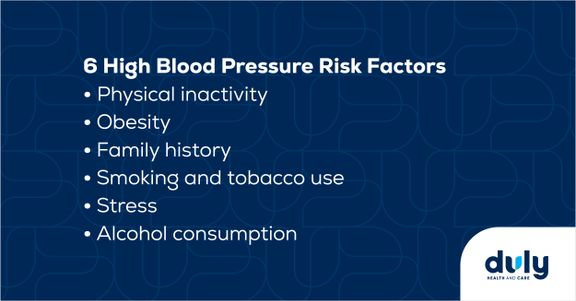High blood pressure isn’t just for middle-agers. In fact, one study showed that nearly 1 in 4 young adults (ages 18 – 39) has high blood pressure, according to data from 2017 – 2020. Many in this group also face challenges like being uninsured, struggling with food insecurity, or living on a low income, which are factors that can make managing their health even harder.
It’s not just adults — kids and teens are affected too. Among 2,600 youths (ages 8 – 19), almost 9% had elevated blood pressure, and over 5% had high blood pressure based on pediatric guidelines.
Also known as hypertension, high blood pressure is defined as having a blood pressure reading of 130⁄80 mm Hg or higher. It happens when the force of blood that pushes against your artery walls remains consistently high. Think of it like water flowing through a garden hose — if the pressure is too high for too long, it can strain the hose (your blood vessels) and potentially cause damage.
Here’s the surprising thing: nearly half of all Americans have high blood pressure, and most of them don’t even realize it. It’s often called the “silent killer” because there are usually no symptoms. That’s why regular check-ups with your primary care provider are important to catch and manage it early!
What’s Causing High Blood Pressure Among Young Adults?
The causes can vary, but stress is a major one. Studies show that people in their late teens to early 30s report higher levels of stress than any other age group, with things like work, money, and the pressure to succeed topping their worry lists.
When you’re stressed, your body goes into fight-or-flight mode — your heart races and your blood pressure spikes. Over time, this constant pressure can lead to hypertension. It’s a reminder that managing stress isn’t just about feeling better mentally. It’s about staying healthy physically too.
If you’re worried you might have high blood pressure, schedule an appointment with your Duly primary care physician today.

Also read: Sober-Curious: Benefits of an Alcohol-Free Lifestyle
High Blood Pressure Symptoms Are Largely Silent
The tricky part of having high blood pressure is that the symptoms usually go unnoticed, so many people don’t realize they have it. In fact, 1 in 3 Americans have uncontrolled high blood pressure and don’t know it.
That’s why establishing a relationship with a primary care provider and regular check-ups are crucial. Managing hypertension typically involves lifestyle changes such as a healthier diet, regular exercise, and possibly medication — but you might not know you need to make these changes if you don’t get diagnosed.
While the symptoms may be sneakily silent, if you ever notice headaches, dizziness, or changes in your vision, it could be a sign that something’s up. Beyond your annual doctor’s visit, many local pharmacies offer quick and easy blood pressure checks. Want to keep an even closer eye on it? Home blood pressure monitors are affordable and make it simple to check your numbers anytime.
Lifestyle Changes vs. Medication
Trade Fast Food for Meal Prepping
If you’re a fast-food foodie, you’re in good company. Americans consume billions in fast food every day, and one study found that 1 in 3 people eats fast food at least once every single day — and the percentage of adults who eat fast food tends to skew younger.
This makes sense — fast food is quick, cheap, and convenient. But while it may be perfect for busy schedules and tight budgets, it’s not so perfect for your blood pressure. Fast food is generally higher in salt and unhealthy fats. This type of diet might save you time today, but it could cost you tomorrow, as it increases your risk for heart disease, stroke, and other serious health problems. It also increases your risk for obesity — and a whopping 75% of hypertension cases are linked to obesity.
Cutting out fast food might seem daunting if it’s already a regular part of your diet. You don’t necessarily need to cut it out completely or go cold turkey (although, turkey is a great source of protein). Try cutting back slowly until it’s no longer an everyday go-to food option. If you’re someone who is constantly on the go, give meal prepping a try. Prepping helps you stay on track with healthy eating and could make it less likely that you’ll run through the drive-through when you get hungry. Some tips to get started include:
- Dedicate a specific night each week for meal planning and prep
- Cook large batches of food to eat throughout the week
- Choose versatile ingredients that can be used in several recipes, such as pulled chicken in a slow cooker
- Chop ingredients in advance so you’re less stressed about cooking
- Put snacks like whole wheat crackers, fruits, veggies, or nuts in convenient grab-and-go baggies
Also read: How Obesity Impacts Your Health
Get Moving
Incorporating regular physical activity into your routine is another powerful way to manage and lower blood pressure, especially for younger adults. The American Heart Association recommends:
- Aerobic exercise: Engage in at least 150 minutes of moderate-intensity aerobic activity a week, like brisk walking, cycling, or swimming.
- Strength training: Include muscle-strengthening activities, like resistance or weight training, at least two days a week.
- Reduce sedentary time: Limit the amount of time spent sitting and incorporate movement throughout your day.
As a young adult, your health isn’t just about avoiding medications — it’s about building a lifestyle that sets you up for long-term success. Take control of your blood pressure today, and your future self will thank you.
Health Topics:


